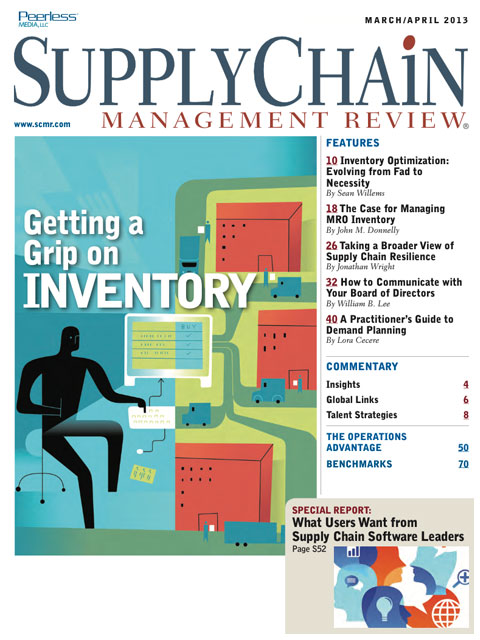Sorry, but your login has failed. Please recheck your login information and resubmit. If your subscription has expired, renew here.
March-April 2013
Inventory needs to be “optimized” to properly match supply and demand. This has become all the more important as competition intensifies globally and supply chains get longer and longer. Learn from a subject matter expert about the benefits of inventory optimization and how to get an IO initiative on track in your organization Browse this issue archive.Need Help? Contact customer service 847-559-7581 More options
In an earlier job, I was the materials manager in a manufacturing facility. A “tool crib” was the repository for office supplies and safety supplies; the bulk of the maintenance, repair, and operations (MRO) inventory was controlled by the maintenance department and was stocked all over the plant.
My group set out to bring best practice in inventory management to the MRO supply chain.
Fasteners were the first MRO component category that we addressed. We selected a supplier to come in and regularly replenish the fasteners in a central stocking area. The supplier inventoried and stocked the bins and invoiced us monthly. This simple process change eliminated the multitude of purchase orders and the associated costs that had been typical of the previous arrangement; it was also designed to ensure that maintenance staff always knew where to get the fasteners they needed for their tasks.
However, there was continued resistance to the idea of the materials management function taking control of all MRO supply. The turning point came when the stock of foundry tapping cones—used to control the flow of molten metal from a furnace ladle—was allowed to run out and the purchasing team had to source and expedite replenishment on a Sunday. It became clear to everyone that it made more business sense to stock foundry supplies in the tool crib. Soon after, additional supplies of tapping cones were moved into the crib. Not only were MRO centrally maintained and ordered after that, but the foundry maintenance area’s housekeeping improved because there were no longer skids of materials sitting around as “maintenance stuff.”
 |
This complete article is available to subscribers
only. Click on Log In Now at the top of this article for full access. Or, Start your PLUS+ subscription for instant access. |
Not ready to subscribe, but need this article?
Buy the complete article now. Only $20.00. Instant PDF Download.
Access the complete issue of Supply Chain Management Review magazine featuring
this article including every word, chart and table exactly as it appeared in the magazine.
SC
MR
Sorry, but your login has failed. Please recheck your login information and resubmit. If your subscription has expired, renew here.
March-April 2013
Inventory needs to be “optimized” to properly match supply and demand. This has become all the more important as competition intensifies globally and supply chains get longer and longer. Learn from a subject… Browse this issue archive. Access your online digital edition. Download a PDF file of the March-April 2013 issue.
 |
Download Article PDF |
In an earlier job, I was the materials manager in a manufacturing facility. A “tool crib” was the repository for office supplies and safety supplies; the bulk of the maintenance, repair, and operations (MRO) inventory was controlled by the maintenance department and was stocked all over the plant. My group set out to bring best practice in inventory management to the MRO supply chain.
Fasteners were the first MRO component category that we addressed. We selected a supplier to come in and regularly replenish the fasteners in a central stocking area. The supplier inventoried and stocked the bins and invoiced us monthly. This simple process change eliminated the multitude of purchase orders and the associated costs that had been typical of the previous arrangement; it was also designed to ensure that maintenance staff always knew where to get the fasteners they needed for their tasks.
However, there was continued resistance to the idea of the materials management function taking control of all MRO supply. The turning point came when the stock of foundry tapping cones—used to control the flow of molten metal from a furnace ladle—was allowed to run out and the purchasing team had to source and expedite replenishment on a Sunday. It became clear to everyone that it made more business sense to stock foundry supplies in the tool crib. Soon after, additional supplies of tapping cones were moved into the crib. Not only were MRO centrally maintained and ordered after that, but the foundry maintenance area’s housekeeping improved because there were no longer skids of materials sitting around as “maintenance stuff.”
 |
SUBSCRIBERS: Click here to download PDF of the full article. |
SC
MR

Latest Supply Chain News
- Retail sales see gains in October, reports Commerce and NRF
- Balancing green and speed: Home delivery insights from the pandemic era
- AdventHealth named top healthcare supply chain by Gartner
- Geopolitical readiness in supply chains: Strategic challenges for leaders
- Unlocking retention: The role employee engagement plays
- More News
Latest Podcast

 Explore
Explore
Latest Supply Chain News
- Retail sales see gains in October, reports Commerce and NRF
- Balancing green and speed: Home delivery insights from the pandemic era
- AdventHealth named top healthcare supply chain by Gartner
- Geopolitical readiness in supply chains: Strategic challenges for leaders
- Unlocking retention: The role employee engagement plays
- Can supply chain managers embrace an entrepreneurial mindset?
- More latest news
Latest Resources

Subscribe

Supply Chain Management Review delivers the best industry content.

Editors’ Picks





